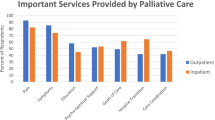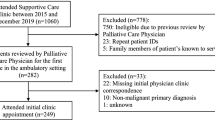Abstract
Purpose
To prospectively compare outcomes and processes of hospital-based early palliative care with standard care in surgical oncology patients (N = 152).
Methods
A randomized, mixed methods, longitudinal study evaluated the effectiveness of a hospital-based Pain and Palliative Care Service (PPCS). Interviews were conducted presurgically and at follow-up visits up to 1 year. Primary outcome measures included the Gracely Pain Intensity and Unpleasantness Scales and the Symptom Distress Scale. Qualitative interviews assessed social support, satisfaction with care, and communication with providers. Survival analysis methods explored factors related to treatment crossover and study discontinuation. Models for repeated measures within subjects over time explored treatment and covariate effects on patient-reported pain and symptom distress.
Results
None of the estimated differences achieved statistical significance; however, for those who remained on study for 12 months, the PPCS group performed better than their standard of care counterparts. Patients identified consistent communication, emotional support, and pain and symptom management as positive contributions delivered by the PPCS.
Conclusions
It is unclear whether lower pain perceptions despite greater symptom distress were clinically meaningful; however, when coupled with the patients’ perceptions of their increased resources and alternatives for pain control, one begins to see the value of an integrated PPCS.

Similar content being viewed by others
Abbreviations
- PPCS:
-
Pain and Palliative Care Service
- NIH:
-
Institutes of Health
- CC:
-
Clinical Center
- NCI:
-
National Cancer Institute
- IRB:
-
Institutional Review Board
- ICU:
-
Intensive Care Unit
- APACHE II:
-
The Acute Physiology and Chronic Health Evaluation
- GPS:
-
Gracely Pain Scales
- SDS:
-
Symptom Distress Scale
- CES-D:
-
Center for Epidemiologic Studies Depression Scale
References
Arnold, B. L. (2011). Mapping hospice patients” perception and verbal communication of end-of-life needs: An exploratory mixed methods inquiry. BMC Palliative Care, 10(1), 1–10.
Bakitas, M., Lyons, K. D., Hegel, M. T., Balan, S., Brokaw, F. C., Seville, J., et al. (2009). Effects of a palliative care intervention on clinical outcomes in patients with advanced cancer: The project ENABLE II randomized controlled trial. Journal of the American Medical Association, 302(7), 741–749.
Barrera, M. (1986). Distinctions between social support concepts, measures, and models. American Journal of Community Psychology, 14(4), 413–445.
Carr, A. J., & Higginson, I. J. (2001). Measuring quality of life: Are quality of life measures patient centered? British Medical Journal, 322, 1357–1360.
Cleeland, C. S. (2001). Cross-cutting research issues: A research agenda for reducing distress of patients with cancer. In K. M. Foley & H. Gellband (Eds.), Improving palliative care for cancer (pp. 233–276). Washington, DC: National Academy Press.
Creswell, J. W. (2009). Research design: Qualitative, quantitative, and mixed methods (3rd ed). Thousand Oaks, CA: Sage.
Creswell, J. W., & Plano Clark, V. L. (2007). Designing and conducting mixed methods research. Thousand Oaks, CA: Sage.
Creswell, J. W., & Zhang, W. (2009). The application of mixed methods designs to trauma research. Journal of Traumatic Stress, 22(6), 612–621.
Del Bufalo, C., Morelli, A., Bassein, L., Fasano, L., Quarta, C. C., Pacilli, A. M., et al. (1995). Severity scores in respiratory intensive care: Apache ii predicted mortality better than saps ii. Respiratory Care, 40(10), 1042–1047.
Devery, K., Lennie, I., & Cooney, N. (1999). Health outcomes for people who use palliative care services. Journal of Palliative Care, 15(2), 5–12.
Gracely, R. H., Dubner, R., & McGrath, P. A. (1982). Fentanyl reduces the intensity of painful tooth pulp sensations: Controlling for detection of active drugs. Anesthesia and Analgesia, 61(9), 751–755.
Gracely, R. H., & Kwilosz, D. M. (1988). The descriptor differential scale: Applying psychophysical principles to clinical pain assessment. Pain, 35(3), 279–288.
Gracely, R. H., McGrath, P., & Dubner, R. (1978). Ratio scales of sensory and affective verbal pain descriptors. Pain, 5(1), 5–18.
Grande, G., & Todd, C. J. (2000). Why are trials in palliative care so difficult? Palliative Medicine, 14(1), 69–74.
Helgeson, V. S., & Cohen, S. (1996). Social support and adjustment to cancer: Reconciling descriptive, correlational, and intervention research. Health Psychology, 15(2), 135–148.
Higginson, I. J. (1999). Evidence based palliative care. There is some evidence-and there needs to be more. BMJ, 319(7208), 462–463.
Higginson, I. J., & Carr, A. J. (2001). Measuring quality of life: Using quality of life measures in the clinical setting. BMJ, 322(7297), 1297–1300.
Higginson, I. J., Finlay, I., Goodwin, D. M., Cook, A. M., Hood, K., Edwards, A. G., et al. (2002). Do hospital-based palliative teams improve care for patients or families at the end of life? Journal of Pain and Symptom Management, 23(2), 96–106.
Hutchison, C. (1999). Social support: Factors to consider when designing studies that measure social support. Journal of Advanced Nursing, 29(6), 1520–1526.
Israel, B. A., & Schurman, S. J. (1990). Social support, control and the stress process. In K. Glanz, B. K. Rimer, & F. M. Lewis (Eds.), Health behavior and health education: Theory, research, and practice. San Francisco: Jossey-Bass.
Jackson, B. S., Strauman, J., Frederickson, K., & Strauman, T. J. (1991). Long-term biopsychosocial effects of interleukin-2 therapy. Oncology Nursing Forum, 18, 683–690.
Karim, K. (2000). Conducting research involving palliative patients. Nursing Standard, 15(2), 34–36.
Knaus, W. A., Draper, E. A., Wagner, D. P., & Zimmerman, J. E. (1985). APACHE II: A severity of disease classification system. Critical Care Medicine, 13(10), 818–829.
Krueger, R. A. (1998). Analyzing & reporting focus groups. Thousand Oaks, CA: Sage Publications, Inc.
Lesage, P., & Portenoy, R. K. (2001). Ethical challenges in the care of patients with serious illness. Pain Medicine, 2(2), 121–130.
Max, M. B., Lynch, S. A., Muir, J., Shoaf, S. E., Smoller, B., & Dubner, R. (1992). Effects of desipramine, amitriptyline, and fluoxetine on pain in diabetic neuropathy. New England Journal of Medicine, 326(19), 1250–1256.
Mazzocato, C., Sweeney, C., & Bruera, E. (2001). Clinical research in palliative care: Patient populations, symptoms, interventions and endpoints. Palliative Medicine, 15(2), 163–168.
McArthur, J. C., Yiannoutsos, C., Simpson, D. M., Adornato, B. T., Singer, E. J., Hollander, H., et al. (2000). A phase II trial of nerve growth factor for sensory neuropathy associated with hiv infection. Neurology, 54(5), 1080–1088.
McCorkle, R., Cooley, M. E., & Shea, J. A. (1998). A user’s manual for the symptom distress scale. Philadelphia: University of Pennsylvania.
Moreno, R., Apolone, G., & Reis Miranda, D. (1998). Evaluation of the uniformity of fit of general outcome prediction models. Intensive Care Medicine, 24(1), 40–47. doi:10.1007/s001340050513.
Morgan, D. L. (1998). Computerized analysis. In R. A. Krueger (Ed.), Analyzing & reporting focus groups. Thousand Oaks, CA: Sage Publications, Inc.
O’Mara, A. M., Germain, D., Ferrell, B., & Bornemann, T. (2009). Challenges to and lessons learned from conducting palliative care research. Journal of Pain and Symptom Management, 37(3), 387–394.
Portenoy, R. K., Thaler, H. T., Kornblith, A. B., McCarthy L. J., Friedlander-Klar, H., Kiyasu, E., et al. (1994). The memorial symptom assessment scale: An instrument for the evaluation of symptom prevalence, characteristics and distress. European Journal of Cancer Part A: General Topics, 30(9), 1326–1336.
Radloff, L. S. (1977). The CES-D scale: A self-report depression scale for research in the general population. Applied Psychological Measurement, 1(3), 385–401.
Sarna, L. (1998). Effectiveness of structured nursing assessment of symptom distress in advanced lung cancer. Oncology Nursing Forum, 25, 1041–1048.
Sarna, L., Lindsey, A. M., Dean, H., Brecht, M. L., & McCorkle, R. (1993). Nutritional intake, weight change, symptom distress, and functional status over time in adults with lung cancer. Oncology Nursing Forum, 20, 481–489.
Shaver, P. R., & Brennan, K. A. (1991). Measures of depression and loneliness. In J. P. Robinson, P. R. Shaver, & L. S. Wrightsman (Eds.), Measures of personality and social psychological attitudes. San Diego: Academic Press Inc.
Standing Medical Advisory Committee, & Committee, Standing Nursing and Midwifery Advisory. (1992). The principles and provision of palliative care. London.
Taylor, E. J. (1993). Factors associated with meaning in life among people with recurrent cancer. Onclology Nursing Forum, 20, 1399–1407.
Ternel, J. S., Greer, J. A., Musilkansky, M. A., Gallagher, E. R., Admane, S., Jackson, V. A., et al. (2010). Early palliative care for patients with metastatic non-small-cell lung cancer. The New England Journal of Medicine, 363, 733–742.
Wallen, G. R., & Berger, A. (2004). Mixed methods: In search of truth in palliative care medicine. Journal of Palliative Medicine, 7(3), 403–404.
Wallen, G. R., Ulrich, C., & Grady, C. (2005). Learning about a “Good Death”: Ethical considerations in palliative care nursing research. DNA Reporter, 30(2), 8–9.
Wills, T. A., & Shinar, O. (2000). Measuring perceived and received social support. In S. Cohen, L. G. Underwood, & B. H. Gottlieb (Eds.), Social support measurement and intervention: A guide for health and social scientists (pp. 86–135). New York: Oxford University Press.
Author information
Authors and Affiliations
Corresponding author
Rights and permissions
About this article
Cite this article
Wallen, G.R., Baker, K., Stolar, M. et al. Palliative care outcomes in surgical oncology patients with advanced malignancies: a mixed methods approach. Qual Life Res 21, 405–415 (2012). https://doi.org/10.1007/s11136-011-0065-7
Accepted:
Published:
Issue Date:
DOI: https://doi.org/10.1007/s11136-011-0065-7




